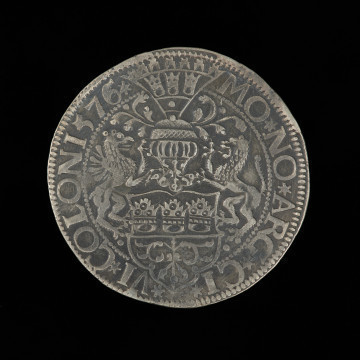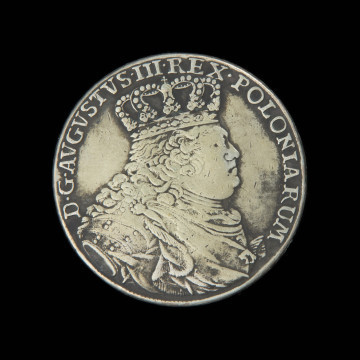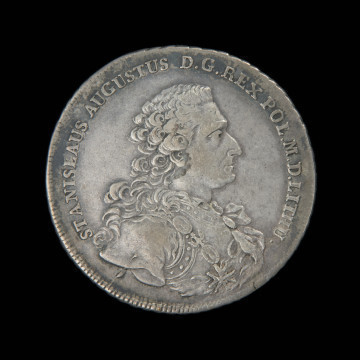
Thaler of the Reich
1576
National Museum in Szczecin
Part of the collection: German coins
The bishopric of Würzburg was founded in 741. In 1168, Emperor Frederick I Barbarossa (1122-1190) made the bishops princes, and the powers of secular rulers in the principality that included part of the lands of the diocese. Using their privileges, the bishops operated their own mint, which would mint impressive thalers. The presented thaler of Adam Friedrich, Graf von Seinsheim (1708-1779), Prince-Bishop of Würzburg in 1755-1779, shows how much attention was paid to the design of these coins. Most noteworthy are the four-field Baroque escutcheon with lion supporters, set against a background of regalia symbolising the sacred (a pastoral) and secular (an unsheathed sword) power of bishops. It is covered by the crown of a prince, another part of the secular regalia. The escutcheon bears the insignia of the two episcopal duchies of Würzburg (the so-called rake and battle flag) and Bamberg (lion rampant, facing right). The principalities were in personal union thanks to Adam Friedrich. The main coat of arms bears the sovereign's family crest – the four-field escutcheon of the Graf von Seinsheim, with a count's crown on top. This gave rise to an impressive escutcheon of the coat of arms, under which the mint's mark was placed - the letter W. Other interesting details can be found in signatures visible in the lower parts of the stamps. On the obverse the letters "R.f" indicate that the stamps were made by medal-maker and engraver Jan Veit Riesing, while the initials INM and FHP on the reverse belong to the mint master Jan Nikolaus Martinen and Franz Herrmann Prange, mint master of the Würzburg mint. Above the coat of arms of the principality is an inscription stating that the coin contains pure silver worth a tenth of a Cologne mark. This makes it the so-called convention thaler minted at the Austrian mint rate of 1750. The principality survived until secularisation in 1803, and after the Napoleonic Wars, its territories were adjoined to Bavaria in 1814.
Mieszko Pawłowski
Other names
Taler
Author / creator
Dimensions
cały obiekt: diameter: 40.7 mm
Object type
coin, money
Technique
minting
Material
silver
Creation time / dating
Creation / finding place
Owner
National Museum in Szczecin
Identification number
Location / status

1576
National Museum in Szczecin

1754
National Museum in Szczecin

1766
National Museum in Szczecin
DISCOVER this TOPIC
Museum of King Jan III's Palace at Wilanów
DISCOVER this PATH
Educational path